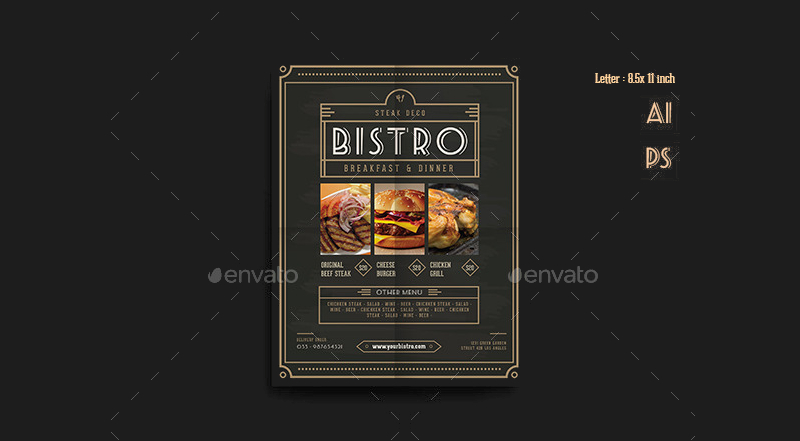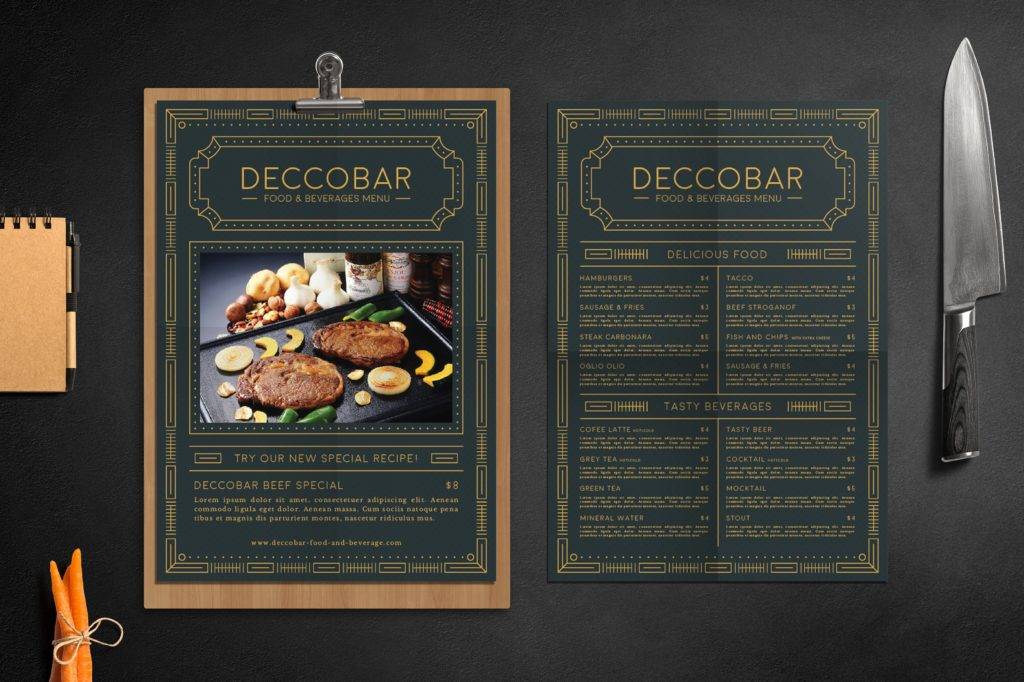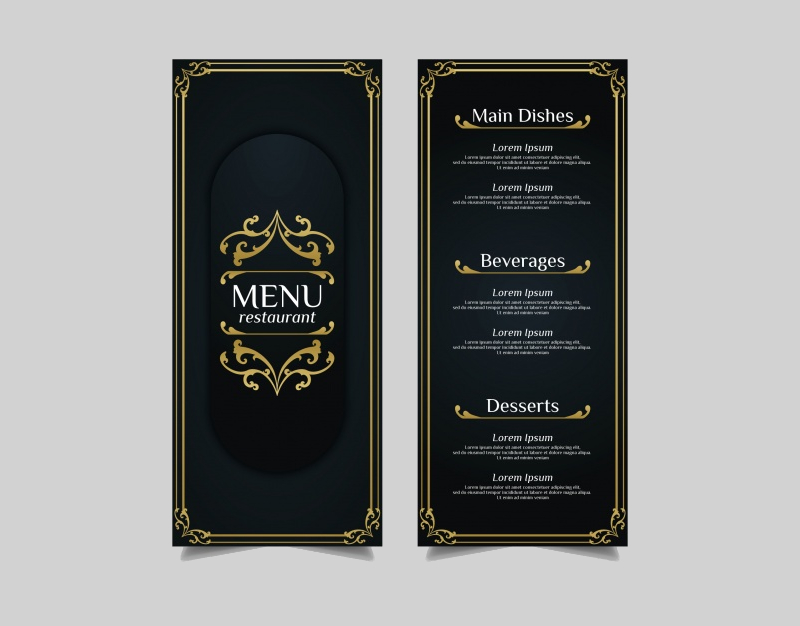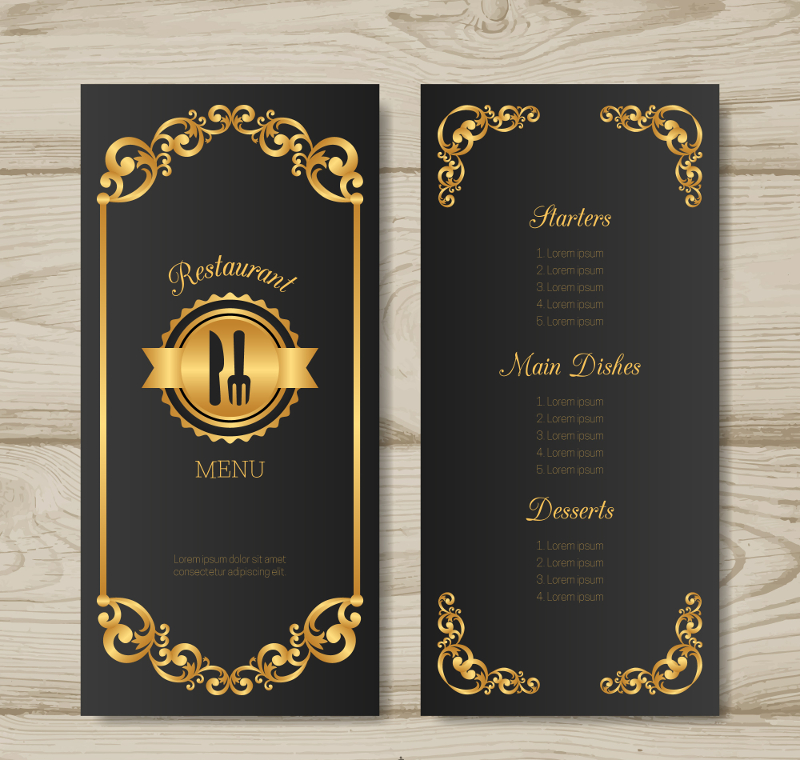16+ Art Deco Menu Examples to Download
As our art styles nowadays are influenced by the manifold art movements from the past centuries, different art styles emerged and made a great impact to our daily living and to our decisions especially on what art style are we going to incorporate in our design. Visual art movement includes realism and the modern art movements such as impressionism, post-impressionism, cubism, fauvism, expressionism, dadaism, surrealism, and pop art. However, we are not going to go in depth of these art movements; instead, we will focus on the idea of Art Deco and the influence of Dadaism and fauvism on this art style. There are more influences on this said art style, but those two have the most significant influence on Art Deco.
The design of Art Deco is recognizable in a snap, but one cannot easily define the characteristics and behavior of an Art Deco design, for this visual art style is quite complicated since the style is a combination and a variant of the different art movements. So what really is Art Deco then and how can one distinguish this art style from another art style? How is this design adopted in business especially in designing a menu?
In this article, we will try to answer these enigmatic questions and we will discuss the key ideas and characteristics of Art Deco as well as the relevance of Art Deco nowadays and the incorporation of this art style to the menu by some companies, restaurants menu, and shops.
Incorporating Art Deco Style in Your Menu
Custom Bar Menu Design

Elegant Restaurant Menu

Art Deco Food and Beverages Menu

Gatsby Art Deco Rose Gold

Food Menu Design Template

Art Deco—the Most Popular Early 20th Century Decorative Style
Art Deco is often described as a pastiche of styles as it imitates various art styles from different art movements. It is said to be one of the most influential and popular decorative styles in the 20th Century. After this has been widely accepted, various disciplines such as fashion, architecture, filmography, and product design applied this art style and became a movement with distinct characteristics although it was inspired from the past art movements. One of its main features is that it is oriented towards modern ideas of progress.
Key Ideas
- Similar to Art Nouveau and like the earlier Arts and Crafts movement, Art Deco embraced all types of art and attempts to infuse functional objects with artistic touches and was considered as the most fashionable international design movement in modern art in the early 1900s. Although both movements are influenced by fine art tradition, there are also distinctions between these influencing styles. One is the boldness of Art Deco in treating and applying shapes and lines.
- Because Art Deco is inclined to modernization, Art Deco artists enhanced the appearance of industrialized objects and machine-age technology rather than traditional crafting methods to produce many objects. As Art Deco is influenced by industrialization and modernization, it incorporated symmetrical arrangements and vibrant and contrasting colors into modern materials such as aluminum, stainless, glass, steel, and plastic. On the other hand, Art Nouveau is centered on the natural environment and the design was inspired by the things from the nature such as wood, trees, leaves, flowers, insects, animals, vines, plants, herbs, shrubs, wings, and feathers.
- Art Deco was also similar to Streamline Moderne in a sense that it showcases architectural design incorporating curving forms, horizontal lines, and nautical elements. Art Deco’s identifying features include vertical emphasis, tower and other vertical projections above roof lines, setbacks, wall surfaces in surfaces, brick, stucco, zigurrat and inverted zigurrat motifs, parallel straight lines, zigzags, chevrons, lozenges, terracotta, glass, colored glazed bricks, mosaic tiles, window strips, iron grille, and casement windows.
Brochure Culinary Menu

Printable Wedding Menu Template

Rustic Art Deco Menu

Characteristics of Art Deco
The nature of Art Deco is that the designs revolved around geometric shapes which can certainly steal viewer’s attention and are highlighted and applied through the designs of floors, walls, mats, ceiling, etc. The supporting designs are complementary patterns and shapes that can make the whole mass of the image. As the word signifies, geometrics is concerned with shapes and figures incorporated into arts and design to make the outcome of mostly intersecting, connecting, or parallel lines as that of a building, walls, rooms, ceiling, floor, etc.
Another characteristic of Art Deco is that it emphasizes and uses bold colors in its design. What are bold colors? They usually consist of solid warm colors and include a few of cool colors. Understanding the color wheel, warm colors are those hues of violet through yellow. Additionally, bold colors include the neighboring color of violet, red. What is the significance of understanding the theory beyond the color wheel?
Classy Art Deco Menu

Vintage Art Deco Menu

There are a lot of implications in studying the color wheel especially in doing a design or creating an artwork. Observe that the three primary colors are placed in a triangular form, blue, yellow, and red. Similarly, the secondary colors—orange, violet, and green—are also placed in the same formation. These are carefully placed in between the primary colors. One of the reasons that understanding these theories is vital is that it displays the relationship between colors may it be complementary or analogous. Complementary colors are colors that are across from each other on the color wheel. For example, in the color wheel above, the complementary color of green is red, and the complementary color of blue is orange. Notice that red, a primary color, is the complementary color of green, a secondary color, and the product color when the remaining primary colors, blue and yellow, are mixed. On the other hand, analogous colors are colors that are close to each other on the color wheel. For instance, using the above color wheel, analogous colors are red and red-orange, red-orange and orange, orange and yellow-orange, and so on.
So, how can these be applied to Art Deco designs? Art Deco artists used bold colors, for example, violet in creating the subject of the design. He or she may embellish the main subject either with analogous colors, to create a visually pleasing harmonic design, or complementary colors, to create a jarring and uncomfortable design. Both can create color harmony and dissonance depending on the personal preference of an artist as long as he or she can express his or her emotional outburst with regard to creating an Art Deco design.
Golden Frame Art Deco Restaurant Menu

As Art Deco is about living large, the design in creating an Art Deco design includes giving accents to varnishes, lacquer, or plush fabrics which can heighten the drama room and can add visual interests to viewers.
It is quite absurd to imagine to use mirrors in the designs, but Art Deco normally incorporated different patterns and shapes of mirrors in its design, giving it a sense of light, drama, and geometrics to the whole subject. The above image is an example of a mirror with patterns and shapes that are beyond the ordinary, plain mirror.
Metallic Finishes
Metallic finishes such as brass and chrome are popular in Art Deco designs. Additionally, Art Deco customarily includes shiny metallic finishes and borders and furnishings. You can immediately point out the metallic finish since it greatly helps in the enhancement of a thing or the subject of the design and gives the colors an intense look with a very high gloss.
Elegant Food Menu

Elegant Restaurant Package Menu

Art Deco Today
Art Deco, a 20th-century art movement, is still branching out its influence in today’s generation. You might not notice the designs around you are vastly influenced by Art Deco since this art style encompasses a very wide range of art styles, influences, and art movements. Among the modern styles that are influenced by Art Deco are as follows:
- Typeface. Fonts and typefaces have been greatly influenced by Art Deco art style, from word documents to other types of files that are constantly used by the people nowadays. It is undeniable that some fonts that are Art Deco “ish” provides a neat and formal font, especially when used for printouts and formal papers. Fonts that have confident lines are examples of this.
- Posters. Poster design has also been greatly affected by Art Deco movement. Linear posters and those that possess great bold colors with embellishments as that of brass and copper perfectly are perfect examples of Art Deco posters. Modern posters prefer the minimalist design and a classy and elegant one; thus, Art Deco makes it perfectly fit the preference of today’s generation.
- Album covers. Album cover from music artists is also an example of an influence of Art Deco in today’s era. As music is always progressing and evolving, the design for the albums are also accepting influences from the different generations and are inclined to the style of Art Deco.
- Banners. Some banner design that is used during events and surprises and advertisements are also inspired by Art Deco in a way that its design includes geometrics and colors with a touch of steel, metals, etc., clearly representing its inclination to Art Deco design.
- Perfume bottles. Some branded perfume bottles have also accepted the great influence of Art Deco in their design. It is indeed classy and elegant for use in the decorations of perfume bottles as it fits the shape and and overall drama of the package.
- Lighting. Lightings have also a touch of Art Deco design. From ceiling lights, corridor lights, to garden lights and light bulbs, the design can also be touched with Art Deco style since light sources can enhance the crispness and color and mirror-like characteristics of Art Deco
- Piano. There also piano sets where you can quickly spot the touch of Art Deco. The design includes the design of the keys up to the pedals and stands. Creative minds really do generate creative ideas in incorporating a certain art style to a physical thing especially in a modern era.
- Cars. Car manufacturers have also built and designed cars where you can clearly observe a touch of Art Deco design on it. Wondering how can Art Deco designs be incorporated into car designs? There are actually a lot of things on how you can decorate your car, and having it painted or customized is the easiest way. Moreover, since most cars have a glossy effect, this adds to the Art Deco effect on it.
- Infrastructures. With so many infrastructures and buildings that seem to be swiftly built for just an overnight, Art Deco can be showcased through these infrastructures through the architects designing the interior as well as the exterior part of a building.
There are so many things from today’s era that are influenced by Art Deco. Try to look around you. You can undoubtedly see different variations or influences of Art Deco in your surroundings, the design of the buildings, as well as from the simple food you eat. With this, we can safely confer that Art Deco is a very broad art style because it can mostly be seen everywhere and its influence is almost on everything around us. Artists took advantage to this era where we are very much inviting and open to changes and improvements and created a rock unbeatable by any kinds of wind for the Art Deco design.
Now that you are already equipped with the basic knowledge about Art Deco and its history as well as the basics of color theory and characteristics of Art Deco and application of these to your menu design, you can challenge yourself in creating your own menu and apply the things that you learned here and appreciate the implications and influence of Art Deco design in today’s generation for we don’t know we are the ones left who knew this kind of art style and pass it to our next generation.
Lastly, remember that your menu is representing your company and one of the things that help greatly to provide your customers with the information about your company and also a part of your branding design which is the overall image of your company that can help you in your advertisement design and in establishing a name in the market.

